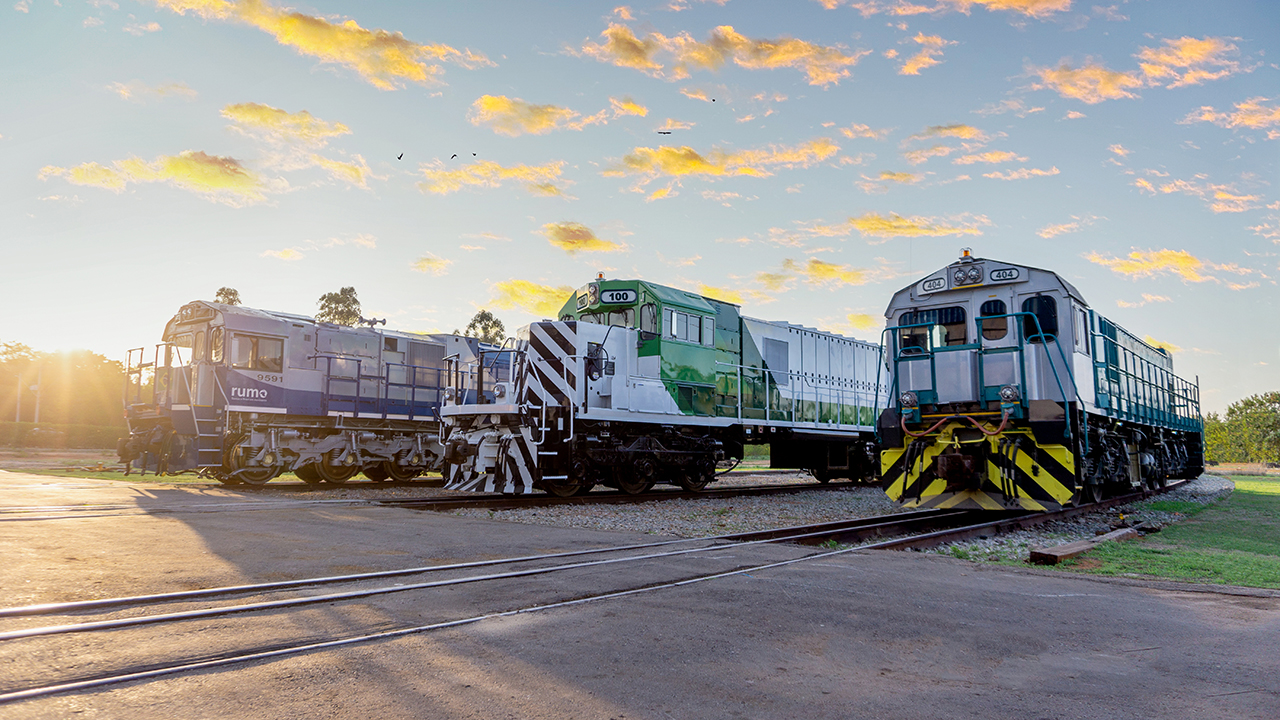Commentary
January 03, 2024 Mechanical
ZE Energy Sources for Locomotives
Written by Alex Luvishis, Ph.D

Left to right: Progress Rail EMD® GT38H hybrid, SD40JR Joule battery-electric, and GT38JC Joule. Progress Rail photo
First, let’s look at the release of harmful substances by locomotives with onboard energy sources. The most prominent is the diesel-electric locomotive. Its electric traction motors are environmentally friendly, but its diesel engine releases harmful substances. An electric locomotive has an environmentally friendly traction drive, but if we want to determine the environmental friendliness of both the traction drive and the energy source, the answer is not so clear.
An electric locomotive’s energy source is a contact network, which consists of a power plant, and line power transmission from a power station to traction substations to catenary or third rail. From all parts of the circuit described above, only the power plant may or may not release harmful substances. If it is a hydroelectric, wind or solar station or a nuclear power plant (except for disposal of spent fuel rods), then it is a zero-emission (ZE) source of energy, and the electric locomotive is completely environmentally friendly. If it is a thermal power plant that burns fossil fuel (coal, oil, natural gas), it emits harmful substances, so the electric locomotive powered by this station is not completely ZE.
An exception is a battery-electric locomotive. Both the traction drive and energy source are environmentally friendly, but a battery-electric locomotive is ZE
only if the batteries are charged from an environmentally friendly source.
In the 21st century, the situation has changed. Modern diesel-electric locomotives meeting EPA Tier 2, 3 and 4 emissions standards are much more sustainable than older units. Battery-electric and HFC (hydrogen fuel cell) locomotives are gradually evolving from the experimental stage, but they are few in number.
Newer battery-electric locomotives use rechargeable batteries significantly superior to those of early units, and their traction motors are also more energy efficient. The batteries of these locomotives require external recharging, so again, a battery-electric locomotive is ZE
only if the batteries are charged from an environmentally friendly source. HFC locomotives are completely environmentally friendly if the hydrogen used is obtained using an electrolyzer powered by electricity from an environmentally friendly source.
The world’s top-five producers of carbon dioxide, percentage-wise, are:
• China: 32.93%
• United States: 12.55%
• European Union: 7.33%
• India: 7%
• Russia: 5.13%
{snip}
 Alex Luvishis, Ph.D. for 18 years headed the laboratory that developed control systems for Russia’s first electric locomotives and asynchronous traction motors in the former USSR. For a further seven years, he headed the rolling stock department at the Institute of Technical Information of Railway Transport in Moscow. Dr. Luvishis is the author of more than 100 articles on electric traction drives and the book “Hybrid Rail Vehicles,” published in 2009. His interests are asynchronous traction drive systems for modern rolling stock, and hybrid drive systems for trams, suburban and regional trains and switching and main line locomotives. He has lived in the U.S. since 1999.
Alex Luvishis, Ph.D. for 18 years headed the laboratory that developed control systems for Russia’s first electric locomotives and asynchronous traction motors in the former USSR. For a further seven years, he headed the rolling stock department at the Institute of Technical Information of Railway Transport in Moscow. Dr. Luvishis is the author of more than 100 articles on electric traction drives and the book “Hybrid Rail Vehicles,” published in 2009. His interests are asynchronous traction drive systems for modern rolling stock, and hybrid drive systems for trams, suburban and regional trains and switching and main line locomotives. He has lived in the U.S. since 1999. 
